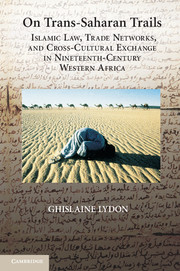 On Trans-Saharan Trails
On Trans-Saharan Trails Book contents
- Frontmatter
- Contents
- Acknowledgments
- Note on Language
- List of Abbreviations
- Glossary
- Maps
- 1 “Making History” Across the African Divide
- 2 Trans-Saharan Trade in the Longue Durée
- 3 Markets and the Movement of Caravans: Nineteenth-Century Developments
- 4 Guelmīm and the Wād Nūn Traders
- 5 The Organization of Caravan Trade
- 6 Business Practice and Legal Culture in a Paper Economy of Faith
- 7 Trade Networks and the Limits of Cooperative Behavior
- 8 On Trans-Saharan Trails
- Appendix 1 Nineteenth-Century Events
- Appendix 2 Pillaged Caravans Reported in the Chronicles
- Bibliography
- Index
1 - “Making History” Across the African Divide
Published online by Cambridge University Press: 02 July 2009
- Frontmatter
- Contents
- Acknowledgments
- Note on Language
- List of Abbreviations
- Glossary
- Maps
- 1 “Making History” Across the African Divide
- 2 Trans-Saharan Trade in the Longue Durée
- 3 Markets and the Movement of Caravans: Nineteenth-Century Developments
- 4 Guelmīm and the Wād Nūn Traders
- 5 The Organization of Caravan Trade
- 6 Business Practice and Legal Culture in a Paper Economy of Faith
- 7 Trade Networks and the Limits of Cooperative Behavior
- 8 On Trans-Saharan Trails
- Appendix 1 Nineteenth-Century Events
- Appendix 2 Pillaged Caravans Reported in the Chronicles
- Bibliography
- Index
Summary
The trans-Saharan trade wove ties of blood and culture between the peoples north and south of the desert.
E. W. BovillIt was the middle of the caravan season when Baghlīl started out with his team of camels on a voyage from which he would never return. The year was 1265 Hijri in the Islamic calendar (1848–9), and by all accounts it was a time of intense warfare aggravated by an outbreak of smallpox that brought about great insecurity on trans-Saharan trails. Baghlīl was a Muslim caravaner of the “Berber” Tikna clan, originally from the Wād Nūn region on the southern desert edge of present-day Morocco. He held residence in the then thriving oasis of Tīshīt, located in the heart of today's Islamic Republic of Mauritania. There he collaborated with other Wād Nūn traders in outfitting camel caravans to transport goods among the markets of Mali, Senegal, and the northwestern shores of the Sahara. When news broke of Baghlīl's passing, one of his partners was chosen to manage his estate and sort out the inheritance, while his Muslim and Jewish “creditors rose to claim their rights,” terminate their written contracts, and settle their accounts in various currencies. Soon another Wād Nūn trader residing in Tīshīt lost his life whilst trading in Senegal. In time, a string of misfortunes and deaths would precipitate a long-distance legal battle, fought with pen and paper by Muslim jurists mediating for the inheriting families of these traders on both sides of the Sahara Desert.
- Type
- Chapter
- Information
- On Trans-Saharan TrailsIslamic Law, Trade Networks, and Cross-Cultural Exchange in Nineteenth-Century Western Africa, pp. 1 - 48Publisher: Cambridge University PressPrint publication year: 2009


